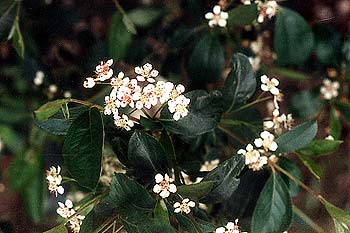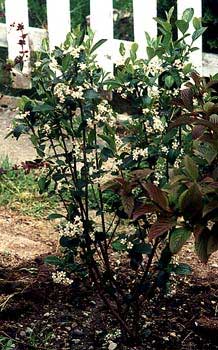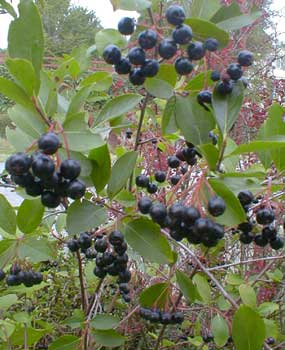 'Autumn Magic'
'Autumn Magic'
Black Chokeberry
"Pure element of waters! wheresoe'er
Thou dost forsake thy subterranean haunts,
Green herbs, bright flowers, & berry-bearing plants,
Rise into life and in thy train appear."
-William Wordsworth
(1770-1850)
(1770-1850)
Black Chokeberry (Aronia melancarpa) can grow to six feet height & width. Since it grows rapidly, we did not have to wait long to see the under-four-feet narrow specimen (shown in the second photo when first planted early in 2002) become an impressive large shrub within a year.
In May it covers itself with white flowers that look exactly like the May flowers on the Hawthorn trees. But when the Hawthorn's flowers are turning into red berries, the Chokeberry's flowers are turning into glossy black ones.
 The berries are commonly used to make juice, & there used to be a west coast company that distributred throughout the west & northwest a bottled alternative to cranberry juice, labeled "Aronia Berry Juice Cocktail," avoiding the name "chokeberry" lest people worry they might choke on it.
The berries are commonly used to make juice, & there used to be a west coast company that distributred throughout the west & northwest a bottled alternative to cranberry juice, labeled "Aronia Berry Juice Cocktail," avoiding the name "chokeberry" lest people worry they might choke on it.It shares with bilberry, cranberry, & other fruit or fruit juices several healthful properties. A 2004 animal-modeled study (Matsumoto et al) conducted at the Department of Food Science & Human Nutrition Faculty of Human Life Science at Fuji Women's University, showed that the antioxidant effects of chokeberry extract had a "gastroprotective" effect in treating acute gastric hemorrhagic lesions in rats, suggesting it might be an effective natural treatment for severe stomach problems in humans, including ulcers. A 2003 study (Malik et al) conducted at the Department of Nutrition and Food Science, University of Maryland, has provided preliminary indication of defense against colon cancer.
A 2002 animal-modeled study (Kowalczyk et al), conducted in the Department of Pharmacology of the Military Medical Academy, Lodz, Poland, tested anthocyanins from black chokeberry. The study concluded that chokeberry anthocyanins might be useful in combating "oxidative stress" in cardiovascular patients. Yet another study (Simeonov et al, 2002) conducted at the Medical University in Plovdiv, Bulgaria, found that chokeberry juice without sugar added (artificially sweetened) was "a valuable adjunct" to treating patients with diabetes. Another Bulgarian study (Borissova et al, 1994) showed that chokeberry juice, due to its anthocyane flavonoids, had an anti-inflammatory value, when inflammation was induced by histamine & serotonin. A great many additional studies have been concluded, either proving or hinting at likelihoods & possibilities of staggering health benifits for blood circulation, urinary tract health, heart health, gastrointestinal health, & much else.
 So many people are enamored of stale ground up dusty particles of "herbal medicines," the majority of which have no effect beyond that of a placebo when tested in doubleblind studies. Yet if such rubes would incorporate more fruit into their diet, & especially such high-antioxidant phenolics in fruits & fruit juices, as can be had from blueberries, cranberries, chokeberries, lingonberries, & suchlike, they might actually obtain many of the benifits they superstiously imagine can be had from ground up garden rubble bought in healthfood stores!
So many people are enamored of stale ground up dusty particles of "herbal medicines," the majority of which have no effect beyond that of a placebo when tested in doubleblind studies. Yet if such rubes would incorporate more fruit into their diet, & especially such high-antioxidant phenolics in fruits & fruit juices, as can be had from blueberries, cranberries, chokeberries, lingonberries, & suchlike, they might actually obtain many of the benifits they superstiously imagine can be had from ground up garden rubble bought in healthfood stores!But fresh chokeberries right from the bush are not particularly tasty raw, being so astringent that even the birds leave them for last, or eat them as a last resort in late autumn or winter. They are full sized & still green in early August, but ripe & shiny black before August's end, & the are least astringent after they have been through a couple of autumn frosts. If harvested they should be used primarily for juice production or pancake syrups, & will need sweetening in the process. Standard steam-method of juice extraction produces two cups of juice per pound of chokeberries. If this is mixed half with a naturally sweet applejuice, no additional sugar will be needed.
They last on the branches until late Autumn or even into winter. Actually they last clear to the next spring but are by then dried out raisony bits, if the birds still have not eaten them before then.
The third little photo shows the fruit in August (2004). There's a page of additional photos snapped showing the fruit color development summer through autumn, on the Chokeberry Page of the Berries Gallery.
This is a native shrub from Eastern North America, ranging from Florida to Nova Scotia, inland as far as Indiana, & as far off as Greenland. It's just terribly forgiving of growing conditions, tolerating swampiness or dryness; acid, neutral, or mildly alkaline soil; full sun or half shade (though it will not have its best appearance in too much shade); are rarely troubled by insects or diseases; & fantastically cold hardy. It is very little stressed by transplanting & a young shrub can be planted in any season with equal success.
About the only thing it can't abide is too much heat. If its ideal condition is met, that would be moist well-draining soil in bright sunshine. In shade it will get lankier but still a nice shrub. It is an excellent street-side shrub, yet with "specimen" possibilities as a center of attention.
The cultivar 'Autumn Magic' originated from an eastern seedling colony. It was brought to the Northwest to be grown & tested by the University of British Columbia Botanical Garden. They discovered that every delightful trait of Chokeberry was even nicer in this slight variant.
'Autumn Magic' had more compact shiny leaves, sets many excellent fruits a whisper larger than the norm, & has brilliant autumn foliage. The bright orange foliage can be seen on the separate Autumn Leaf Gallery's Chokeberry Page.
It can be propogated from soft cuttings taken late spring or early summer. Take the cutting a half-inch below a node, cutting at a sharp smooth angle, touching the raw end with rooting hormone, & start it rooting in a coldframe or covered pot. Chokeberries can also be propogated from seed, but seed-grown specimens may or may not be identical to 'Autumn Magic.' A third method of propogation is merley to slice off suckers with a spade & transplanting them immediately into the areas new shrubs are wanted.
It does have a suckering, colonizing habit which means it can't be entirely ignored if one doesn't want it spreading about. But even this is a small criticism since it is not nearly as aggressive in its suckering as its nearest cousin, red-berried A. arbutifolia, & in our garden 'Autumn Magic' has not suckered much at all.
I love so many North American native shrubs, & chokeberry is one of the best of a grand lot.